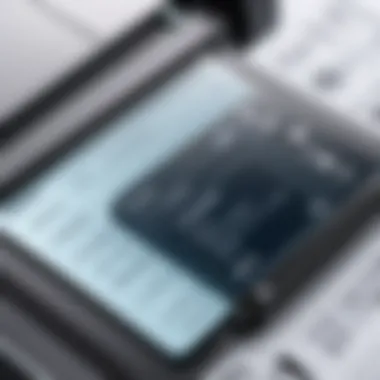Label Printer Apps: Functionality and Trends


Intro
The usage of label printer apps has become increasingly popular in recent years. Their functionality has evolved significantly, serving a multitude of purposes across various sectors. From personal organization to complex labeling needs in professional environments, these apps are integral to streamlining tasks. The rise of such technology indicates a shift towards greater efficiency and utility in labeling processes.
Understanding the capabilities and features of these applications is crucial for decision-makers and IT professionals seeking the best solutions. Evaluating the options available can lead to improved workflows and productivity, tailoring the choice to specific requirements. This exploration will shed light on essential aspects that define the label printer app landscape.
Prelude to Label Printer Apps
The digital transformation of various industries continues to reshape how businesses operate. At the forefront of this shift are label printer apps, which have emerged as essential tools for automating and streamlining labeling processes. The importance of label printer apps lies in their ability to enhance efficiency and accuracy across many sectors, from retail to logistics. As organizations increasingly rely on automation, understanding how these apps function becomes critical.
Definition and Purpose
Label printer apps are specialized software solutions designed to create and print labels for a variety of applications. These apps cater to different needs, such as product labeling, inventory management, and personalized labeling for events. Their primary purpose is to simplify the labeling process, enabling users to design customized labels with ease.
The user interface of these apps typically facilitates a straightforward label design experience, allowing individuals with minimal technical skills to produce professional-looking labels swiftly. Features such as barcode generation, text formatting, and graphics integration further enhance their utility.
Historical Context
The evolution of label printing technology has roots in the early days of commercial printing. Initially, printing labels required substantial resources, often using large, expensive machinery in dedicated print shops. As technology advanced, the introduction of desktop printers gave rise to a new era of label printing, making it accessible from any office or home.
By the late 1990s, the emergence of computer software revolutionized the process. Programs began to appear, enabling users to design labels on personal computers. Today, the rise of mobile devices and applications sees label printing in a new light, allowing users to print directly from their smartphones or tablets. This shift not only broadens access but also enhances the speeds and efficiencies with which businesses produce labels, and thus, label printer apps have become an integral part of modern operational workflows.
Key Features of Label Printer Apps
Label printer apps represent a significant advancement in the realm of labeling solutions. Understanding their key features is essential not only for users but also for decision-makers who endeavor to integrate these tools into their operational workflows. They can dramatically influence productivity, customization, and integration capabilities, all of which are crucial when selecting the right software for printing labels.
User Interface Design
The user interface (UI) of label printer apps plays a vital role in user experience. An intuitive UI allows users to navigate the app effortlessly, minimizing training time and increasing the likelihood that users will engage fully with the software. A well-designed UI often features clean layouts, accessible menus, and easy-to-find tools to create and print labels without confusion. For instance, apps like DYMO Connect offer drag-and-drop features, making it simple for users to arrange text, styles, and barcodes visually. In contrast, a cluttered or overly complex UI may lead to user frustration and decreased productivity. A smooth experience will also reduce errors, as users can operate the software without unnecessary complications.
Customization Options
Customization is a critical feature that enhances the practicality of label printer apps. The ability to tailor labels to specific requirements can involve different font styles, sizes, colors, and graphics. Furthermore, advanced tools can support custom templates, allowing organisations to create a cohesive branding experience across all labels. Additionally, many apps allow users to import images or logos for personalisation, which can be essential for businesses wanting to enhance their professional image. A notable example is Brother’s P-touch Editor, which excels in providing users with numerous customization options, fostering creativity while maintaining brand identity.
Integration with Other Software
Seamless integration with other software is critical in today's interconnected digital landscape. Label printer apps that can easily connect with existing systems such as inventory management or shipping platforms will offer substantial benefits. Integration reduces the need for repetitive tasks by allowing automatic importation of data for label creation. For example, applications that work with tools like Zapier can significantly streamline the workflow by facilitating connections between different software solutions. The enhanced efficiency from such integrations can lead to time savings and reduced operational errors, making them indispensable for multi-faceted organizations.
Benefits of Using Label Printer Apps
In the realm of modern business and personal organization, the utilization of label printer apps presents a plethora of advantages. As efficiency becomes paramount in both professional and personal settings, understanding these benefits is crucial for decision-makers, IT professionals, and entrepreneurs. The importance of these apps lies not only in enhancing productivity but also in offering cost-effective solutions and ensuring ease of accessibility.
Efficiency in Label Production
Label printer apps significantly streamline the process of label creation and printing. Traditional methods often require manual input and extensive time, but these applications automate many of those tasks. Users can quickly select templates, input data, and print labels with just a few taps or clicks. This speed reduces time spent on label production, allowing users to focus on other critical tasks. Moreover, automation helps in minimizing human errors, which can be particularly costly in environments like retail or logistics.
"Efficiency in label production is not just about speed, but also about precision and reduced error rates, leading to better overall performance."
Another factor enhancing efficiency is the capacity for batch printing. Users can print multiple labels simultaneously, which is especially useful during peak periods. Scanning or importing data directly from spreadsheets or inventory management systems eliminates repetitive manual entry, further saving time.


Cost-Effectiveness
Using label printer apps can lead to substantial cost savings in various ways. First, the reduction in time spent on label creation translates directly to labor cost savings. Fewer hours worked on label management means more efficient use of human resources.
Additionally, many label printer apps operate efficiently with minimal material waste. When labels are precisely designed, there are fewer misprints and wasted materials, such as paper or ink. Users can also explore print-on-demand options, which can prevent overproduction and excessive inventory costs.
Furthermore, many apps offer free or low-cost versions, providing flexibility for small businesses or freelancers who may not have large budgets for software. This affordability makes it easier for individuals and organizations alike to access robust labeling solutions without significant upfront investment.
Accessibility and Portability
One of the key advantages of label printer apps is their accessibility across various devices. Many applications are designed to operate seamlessly on smartphones, tablets, and computers. This versatility allows users to design and print labels from virtually anywhere, whether they are in the office, at home, or on the go.
Moreover, the synchronization capabilities of these apps enable users to access their label designs from multiple devices. For decision-makers, this means that critical labeling needs can be addressed in real-time, without the traditional barriers of location or device compatibility.
Types of Label Printer Apps Available
Understanding the types of label printer apps is crucial for individuals and businesses looking to optimize their label printing processes. Different categories of apps suit distinct needs and preferences. Recognizing these types can lead to more efficient label creation and printing. This section will cover the three primary categories: mobile apps for smartphones and tablets, desktop software options, and web-based applications. Each category offers unique strengths and can greatly enhance productivity in various settings.
Mobile Apps for Smartphones and Tablets
Mobile applications have gained significant traction in recent years. These apps allow users to print labels directly from their smartphones or tablets. The convenience of mobile label printing can reduce time spent at a workstation. Users can create and manage labels on the go, which is particularly beneficial for those in retail or logistics.
Popular mobile apps, such as Brother iPrint&Label or DYMO Connect, provide user-friendly interfaces. They often include features like barcode creation, templates, and customization options. This accessibility allows smaller businesses or entrepreneurs to maintain flexibility in their operations. Data synchronization with devices is also a key feature, ensuring that users can work seamlessly across platforms.
Desktop Software Options
Desktop software options are robust alternatives for organizations that require more advanced functionalities. These applications typically offer comprehensive tools for designing and printing labels. Users like IT managers and administrative staff often prefer desktop software due to its extensive features and capabilities. Some popular software includes NiceLabel and BarTender.
With desktop solutions, users can benefit from:
- Advanced Design Features: Allows for intricate designs with various elements like logos and images.
- Integration Capabilities: Users can connect these applications to inventory management systems or databases, streamlining operations.
- Multi-User Access: Ideal for larger teams, ensuring multiple people can work on projects simultaneously.
While these applications may have a steeper learning curve, their depth makes them suitable for professional settings demanding precision and control.
Web-Based Applications
Web-based applications for label printing have emerged as a flexible option. They require no installation and can be accessed from any device with internet connectivity. This is particularly useful for businesses with remote teams. Solutions like Canva and Avery Design & Print live in the cloud, offering easy collaboration and sharing.
Key advantages of web-based applications include:
- Cross-Device Compatibility: Users can access their projects from desktops, tablets, or smartphones.
- Automatic Updates: Users benefit from the latest features without worrying about manual updates.
- Cost-Effectiveness: Many web-based apps offer free tiers or low subscription costs, making them accessible for startups and small enterprises.
Industry Applications of Label Printer Apps
Label printer apps serve various industries, emphasizing their versatility and adaptability. They enhance productivity, organization, and accuracy. Understanding their applications helps businesses optimize their processes and improve overall efficiency.
Retail and E-Commerce
In the retail and e-commerce sectors, label printer apps streamline operations significantly. They enable businesses to create customized labels that reflect branding and product information. This aspect is crucial for consumer engagement. Accurate labeling ensures that customers receive correct information about the product, enhancing customer trust.


The integration of label printer apps with e-commerce platforms like Shopify or WooCommerce makes it easy to print shipping labels and barcodes directly. This reduces the manual entry process, which minimizes errors and saves time. Furthermore, labels can be tailored to include branding elements, such as logos and colors, enhancing brand recognition.
- Customized labels improve customer experience.
- Quick printing boosts efficiency during busy seasons.
- Reduced errors enhance sales processes.
> "In retail, accurate labeling is not just about compliance; it’s about enhancing the journey for the customer."
Healthcare and Pharmaceuticals
Label printer apps are vital in healthcare settings. They ensure that medications and supplies are correctly labeled, which is essential for patient safety. These apps aid in the production of labels that adhere to regulatory standards and contain critical information like dosing instructions and expiration dates.
In busy healthcare environments, the speed of label production can impact treatment times. Label printer apps make it possible for healthcare professionals to quickly print labels on demand. This immediacy allows for more time dedicated to patient care rather than paperwork.
- Ensures compliance with healthcare regulations.
- Reduces medication errors leading to patient safety.
- Facilitates quick access to relevant information during emergencies.
Manufacturing and Logistics
In the manufacturing and logistics sectors, label printer apps play a pivotal role in maintaining workflow efficiency. These applications enable the creation of labels for inventory management, shipment labeling, and product identification. Correct labeling in these areas is key to operational accuracy.
Label printer apps can integrate with inventory management systems to track goods accurately throughout various stages of production and delivery. This integration helps companies to respond to shifts in demand promptly and minimizes stock discrepancies, which can lead to financial losses.
- Streamlines inventory tracking.
- Enhances shipping accuracy with clear labeling.
- Supports compliance with safety and regulatory standards.
Understanding the specific applications of label printer apps across all these industries facilitates better decision-making for technology investments, ensuring that businesses choose solutions that align with their operational needs.
Evaluating User Feedback and Experiences
Understanding user feedback and experiences is essential when examining label printer apps. These insights offer a window into how users interact with the apps, their pain points, and overall satisfaction levels. Evaluating this feedback helps to identify trends and areas for improvement, contributing to more user-friendly products and better customer retention. Moreover, it allows developers to align their offerings with user expectations, creating solutions that meet market demands. This evaluation serves as a gauge of an app’s effectiveness in real-world scenarios, beyond what marketing materials suggest.
Common User Concerns
User concerns often revolve around a few key areas: functionality, usability, and technical support. Users want to ensure that the app can perform the tasks they require without excessive interruption or errors. Some common concerns include:
- Compatibility Issues: Users frequently report challenges when apps do not work well with their existing hardware or other software tools.
- Features and Flexibility: Many express dissatisfaction when an app lacks customization options or advanced features they consider essential for their workflows.
- User Support: Concerns about the availability of reliable customer support when issues arise lead users to hesitate in choosing an app.
- Cost vs. Value: Often, users question whether the price point aligns with the features they receive, advocating for transparent pricing structures and trial options.
Understanding these concerns is critical for any stakeholder considering label printer apps, as addressing them can significantly enhance user satisfaction and loyalty.
Best Practices for Optimizing Use
To maximize the potential of label printer apps, adhering to best practices is crucial. Here are a few recommended strategies:
- Regular Updates: Keep the app updated to ensure compatibility with the latest devices and to incorporate new features or improvements.
- Thorough Onboarding: Take advantage of onboarding tutorials or guides within the app. This can help users understand all the functionalities available.
- Utilize Feedback Channels: Encourage users to provide feedback regularly. This helps in identifying issues early and fosters a community of engagement around the app.
- Integrate with Existing Tools: Assess how well the app integrates with other software in use. Seamless integration can significantly boost productivity.
- Evaluate User Roles: Understand who will be using the app and tailor functionalities to meet diverse needs, from basic users to advanced ones.
Implementing these practices can lead to more efficient use of label printer apps, driving better results across both personal and professional settings.
Market Trends and Future Developments
Understanding market trends and future developments in label printer apps is essential for grasping how technology is evolving within this space. As businesses and individuals increasingly rely on these applications for efficient labeling solutions, the dynamics surrounding them are constantly changing. Potential innovations can lead to improved functionality, while shifts in consumer preferences inform app developers about features that matter.
Innovations in Label Printing Technology


Recent innovations in label printing technology have transformed the landscape of labeling solutions. One significant trend is the integration of artificial intelligence and automation into label printer apps. These technologies can enhance the user experience by simplifying the design process and enabling predictive analytics for inventory management. For example, apps can now automatically suggest label sizes and designs based on the user's needs, reducing the time spent on planning and execution.
Another important development is the rise of mobile printing capabilities. Many apps now support direct printing from smartphones and tablets, making label creation accessible from anywhere. This flexibility is particularly valuable in fast-paced environments, like retail and warehousing. Users can print labels directly by scanning barcodes, leading to a seamless workflow.
"The advent of cloud-based solutions in label printing technology allows users to manage and share label designs across various platforms, enhancing collaboration and efficiency."
The move towards eco-friendly materials is also notable. Companies are more aware of their environmental impact and are seeking sustainable options for labels. This includes using biodegradable or recyclable materials which can positively influence a company’s public image.
Shifts in Consumer Preferences
As technology evolves, consumer preferences are shifting correspondingly. Users today prioritize ease of use and intuitive interfaces when choosing label printer apps. A streamlined onboarding process and clear navigation can significantly impact user satisfaction, resulting in increased adoption of specific applications.
Furthermore, personalization is becoming a widespread trend. Users want the ability to customize their labels to reflect brand identity and individual preferences. This has led to a greater emphasis on customization options within applications. Features that were once considered optional are now essential, including color matching, logo insertion, and unique typography.
Cost-effectiveness also plays a vital role in consumer decisions. Users are increasingly looking for solutions that offer a good balance between price and functionality. Many prefer apps that provide comprehensive trials, allowing them to test features before committing.
Selecting the Right Label Printer App
Choosing the appropriate label printer app is a crucial step in optimizing your label production process. The rise in digital solutions for printing and labeling has made it essential to identify an app that caters specifically to your requirements. A suitable app can enhance efficiency, reduce overhead costs, and improve overall usability.
Understanding the diverse functionalities of label printer apps is vital. You need to consider factors such as compatibility with devices, ease of use, and the scope of features offered. Each application has its unique strengths and weaknesses, which may affect your decision based on your industry or specific needs.
Assessing Individual Needs
When evaluating options, first look at your distinct requirements. Different users have varying expectations from label printer apps. Here are some factors to consider:
- Volume of Labels: If you regularly print large volumes, opt for an app that supports batch printing.
- Label Designs: If you require complex designs or customizations, look for apps providing robust design tools.
- Integration Needs: If you use various software systems, ensure the app can integrate seamlessly with them.
- User Skill Level: Consider your team's expertise. Some apps are more user-friendly than others.
- Mobility: For those who need to print on-the-go, mobile compatibility is crucial.
Identifying these needs allows you to narrow down your options significantly.
Comparative Analysis of Popular Options
Once you’ve assessed your requirements, the next step is to conduct a comparative analysis of popular label printer apps. Here are several noteworthy options:
- Dymo Connect: Known for its simplicity, Dymo Connect is effective for basic label tasks, ideal for home or small office use. However, it may lack advanced features required by larger organizations.
- Avery Design & Print: This app offers extensive free templates and design possibilities, suitable for both personal and professional use.
- Label Maker by TSC: More geared towards enterprise users, it provides advanced functionalities, bulk printing, and integration options.
- Brother iPrint & Label: This mobile app allows users to print directly from smartphones and tablets, providing flexibility and convenience.
When comparing these options, consider user reviews and feedback. This can shed light on real-world usability and potential pitfalls of each application.
Selecting the right app is not merely about features; it's about aligning those features with your specific operational needs and context for maximum effectiveness.
Culmination
In today's dynamic business environment, the role of label printer apps cannot be overstated. These applications have evolved to become essential tools for various industries, allowing for streamlined label production and enhanced operational efficiency. This article emphasizes several crucial aspects that underscore the significance of selecting the right label printer app.
Summary of Key Points
The exploration of label printer apps revealed several key takeaways:
- User Interface: A well-designed user interface is paramount. It improves usability and ensures that users can navigate the app with ease.
- Customization: The ability to customize labels according to specific requirements adds significant value, especially in sectors like retail and logistics where branding and detail are crucial.
- Integration: Integration capabilities with other software enhance data consistency and operational workflows.
- User Feedback: Understanding user experiences provides insight into common issues and best practices that can inform future use.
- Market Trends: Awareness of current trends, such as technological innovations and shifting consumer preferences, is vital for adapting to changes and maximising app effectiveness.
Implications for Future Use
The implications drawn from this analysis suggest that the landscape of label printer apps will continue to grow, driven by advancements in technology and the increasing need for efficiency. Decision-makers should consider the following:
- Investing in Technology: Staying abreast of innovations in software and hardware can yield substantial benefits, such as increased productivity and reduced errors in label printing.
- Tailored Solutions: It is vital to choose a label printer app that aligns with specific organizational needs rather than a one-size-fits-all approach.
- Continuous Feedback Loop: Engaging with users for ongoing feedback can enhance the app's functionality and user satisfaction.
- Future Trends: Keeping an eye on emergent trends will allow companies to strategically position themselves, ensuring they utilize the most relevant tools in an evolving market.



